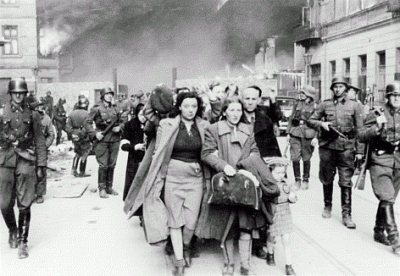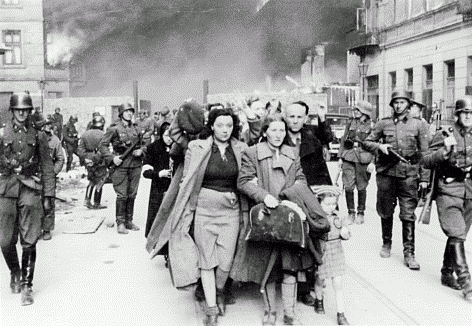
The Warsaw Ghetto
But it wasn’t until I recently watched A Film Unfinished, Yael Hersonski’s 2010 documentary, that I realized the Warsaw Ghetto was only one degree of separation from the concentration camps that they foreshadowed. The title A Film Unfinished signifies is the filming it chronicles of an eventually aborted propaganda film about the Warsaw Ghetto by the Nazis shortly before its liquidation.
As background, the Nazis filmed street scenes of a restless, haunted city, with children dying of malnutrition before your eyes and corpses in the street – as well as those in the moneyed classes ignoring the squalor around them. The Nazis also created sets of luxurious apartments with actors portraying Jews dining well and enjoying themselves, to make it appears as if affluent Jews were profiting at the expense of poor Jews. One suspects, though, that the film was never completed because the Nazis realized that viewers – no matter how “good Germans” they were – couldn’t help but ask themselves how most of the Jews suddenly found themselves in such horrible straits in the first place. In other words, the finger inevitably points back at the Nazis.
When A Film Unfinished was released, it was rated “R.” The Wall Street Journal reported:
“A Film Unfinished”. … shows the human rights atrocities we all associate with the holocaust, and the graphic imagery earned the movie an “R” rating from the MPAA. But is “A Film Unfinished” an important educational tool? That’s the argument being made by Oscilloscope Laboratories, the company releasing “A Film Unfinished.” Adam Yauch, a member of the rap group Beastie Boys and the co-founder of the distributor, railed against the MPAA’s decision, which makes it difficult for the documentary to be shown to minors in an educational setting. … David Fenkel, the company’s co-founder, said the ruling isn’t “consistent with cultural norms,” citing the graphic footage on display at the United States Holocaust Memorial Museum in Washington, D.C., which is visited by school children.
Still, the “R” rating can be taken as a backhanded compliment, a testimony to the power An Unfinished Film holds over more graphic films. The New York Times pronounced it “Moving, mysterious and intellectually provocative.” But An Unfinished Film is much more than that. Because of the repetition, partly through outtakes, of street scenes, the viewer becomes increasingly familiar with the same street, the same buildings, some of the same people. In fact, the viewer’s immersion in the Warsaw Ghetto is total. Insidiously effective, A Film Unfinished indelibly stamps the Warsaw Ghetto on our consciousness.
